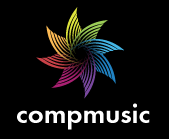MusicBrainz
One of the goals of the CompMusic project is to make the musical cultures we are studying more accessible for research. It holds an integral part of the our work plan. We aim to gather information of the musical repertoires within the selected cultures, including audio music files, metadata, descriptions, scores, plus all the needed cultural and sociological information to contextualize the music.
We are initially focusing on commercially available audio recordings, which are easily accessible and give us an easy way to gather metadata. We cannot distribute the audio recordings but we can share the metadata of the CDs using existing open data services, such as MusicBrainz.
MusicBrainz is "an open music encyclopedia that collects music metadata and makes it available to the public." It aims to form a trusty central database to identify music CDs and it encourages contributions by using an open license model. In MusicBrainz anyone can add the metadata of CDs such as the names of tracks, the label of the release and the artists featured in the album. Yet, MusicBrainz is more ambitious than just being a database of metadata of CDs, it also allows to add detailed information about the music, such as personal details of artists, composer/lyricist information, or the specific date of a performance. Even more, the MusicBrainz database can maintain relationships between the data entities.
MusicBrainz defines each entity (such as artist, release and track) with a universally unique identifier named MusicBrainz ID (MBID). The MBIDs provide "a reliable and unambiguous form of music identification." First, they can be used to disambiguate entities having the same name. As an example, think of the instrumental pieces in Ottoman classical music, which are named by the makam and the form (i.e. Hicaz Saz Semaisi). In such cases each piece will have a distinct MBID. Additionally, MBIDs allows a straightforward format for crawling, querying and searching.
Apart from the expandable and flexible nature of the MusicBrainz database, a prominent advantage is its open licencing model. Open licenses promote that a "creative work can be reused, revised, remixed and redistributed (4Rs)." Since CompMusic project aims for accessibility and openness, this concept/philosophy is an integral part of our goals. Technically, the data in MusicBrainz uses two different licenses. The core data (artists, releases, labels etc.) is made available as public domain, which means it can be accessed and used without any restrictions, whereas the remaining data (folksonomy tags, edits, wiki pages etc.) is made available under Creative Commons Attribution-NonCommercial-ShareAlike 2.0, which "allows non commercial use of the MusicBrainz data as long as MusicBrainz is given credit and that derivative works (works based on MusicBrainz CC licensed data) are also made available under the same license."
In CompMusic we are currently using MusicBrainz to store the metadata of our music collections and to browse through them. We are creating a collection in MusicBrainz for each of the music repertories we have started to work on: Ottoman, Andalusian, Carnatic, and Hindustani. We want to encourage people to contribute with new information but we are conscious that is not easy to learn how to add information to the database and how to link it with the existing data entities. To facilitate this process we have made two video tutorials explaining the steps to be carried out. The first video is about how to add details to an existing album:
and the second video tutorial is about how to add a new album by using MusicBrainz Picard.
Hopefully this information will help and encourage people to contribute to CompMusic by uploading metadata of CDs from the cultures we are studying. If you have any problem do not hesitate to contact us.


